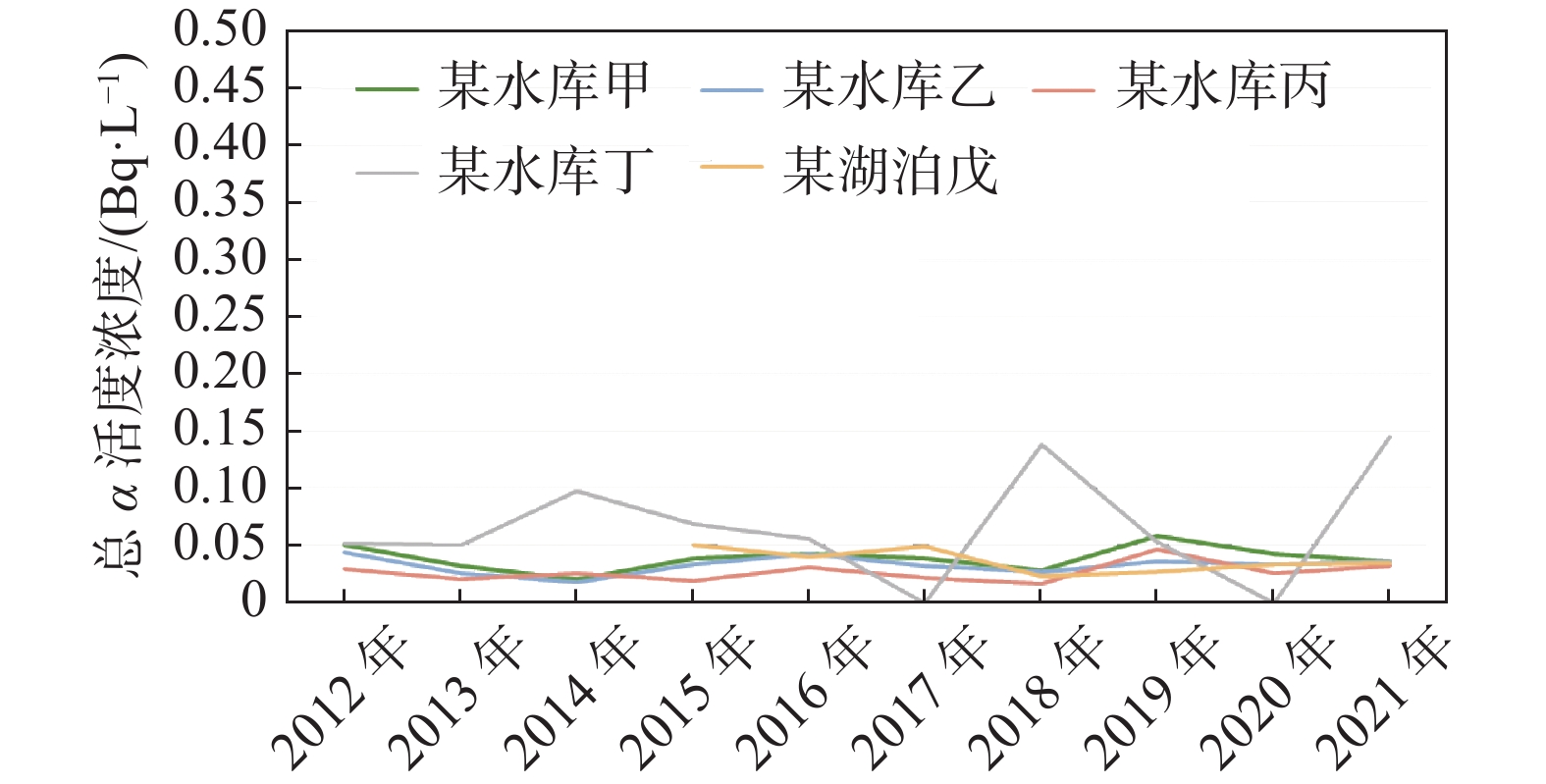生活饮用水是人类生存不可缺少的要素,与人们的日常生活密切相关。生活饮用水的安全一直是人们所关心的问题,而其中放射性水平也是反映水质状况的一个重要指标,饮用水中的放射性物质被摄入人体内将会对人体健康产生一定的影响。为掌握北京市重要饮用水水源地的放射性水平,加强对饮用水源地的管理提供可靠的监测数据支持和资料,本研究开展了饮用水水源地总α、总β放射性水平监测,对2012—2021年北京市部分饮用水水源地中总α、总β放射性监测结果进行分析与评价。
1 材料与方法 1.1 材料 1.1.1 样品的来源2012—2021年每年的枯水期、丰水期对北京市9个地下水水源地以及5个湖库水系的地表水水源地的采样点(含自采样品及送检样品)进行总α、总β放射性的分析。样品的采集依据《辐射环境监测技术规范》(HJ/T 61—2001)[1]中对地表水、饮用水、地下水采样的相关要求进行。采集水样后,按1 L水样加20 mL + 1 mL硝酸的比例,将相应量硝酸加入聚乙烯扁桶中,水样于低温下保存,并尽快分析。
1.1.2 测量仪器德国Berthold公司生产的LB770 10通道低本底α/β监测仪。
1.2 方法根据《水中总α放射性浓度的测定 厚源法》(EJ/T 1075—1998)[2]、《水中总β放射性测定 蒸发法》(EJ/T 900—94)[3]进行预处理和测量。进行了酸化、蒸发浓缩、灰化等一系列前期处理,使用研钵进行研细残渣,混匀,制成待测样,使用低本底α、β测量装置测量其总α、总β活度浓度。
1.3 测量与分析 1.3.1 标准源以镅-241(241Am粉末源)(比活度为10.2 Bq/g)作为α标准源,以钾-40(KCl氯化钾粉末源)(比活度为14.4 Bq/g)作为β标准源,对低本底α/β监测仪进行标定。
1.3.2 计算公式仪器软件中的各种结果数据公式计算 α放射性浓度:
| $ {C}_{\alpha}=\frac{\left({R}_{{x}}-{R}_{0}\right)}{\left({R}_{{s}}-{R}_{0}\right)} \times \alpha_{{s}} \times \frac{{m}}{1\;000} \times \frac{1.02}{V} $ | (1) |
总β放射性浓度:
| $ {C}_{\beta}=\frac{\left({R}_{{x}}-{R}_{0}\right)}{\left({R}_{{s}}-{R}_{0}\right)} \times \beta_{{s}} \times \frac{{m}}{1\;000} \times \frac{1.02}{V} $ | (2) |
公式1)、2)中:Cα、Cβ:分别为样品总α、总β放射性活度浓度(Bq/L);Rx:样品源的总α或总β计数率(s−1);Ro:本底的总α或总β计数率(s−1);Rs:标准源的总α或总β计数率(s−1);αs、βs:分别为标准源总α、总β放射性活度浓度(Bq/g);V:液体样品的取样体积(L);m:取样样品蒸干、灼烧后的残渣总质量(mg);1.02:校正系数,即1 020 mL酸化样品相当于1 000 mL原始样品。
1.4 质量控制①采样、制样和测量分析方法采用国家规定的标准方法和规范;低本底α、β测量装置定期进行校准与确认,在校准有效期内使用;②参加同行业组织的总放测量能力验证与实验室间比对工作;③定期测量仪器本底,做好质控记录;用电镀源定期检查仪器的长期稳定性。
2 结 果 2.1 概述对2012—2021年北京市饮用水枯水期、丰水期的总放射性水平进行研究。采样点基本遍及了北京城区和远郊区,研究面涉及地下水和地表水,9个地下水水源地为某水厂A、B、C、D、E、F、G及某水井H、I;5个地表水水源地采样点位为某水库甲、乙、丙、丁和某湖泊戊,共计14个点位的总放射性水平。地下水与地表水的样本数情况见表1。
|
|
表 1 北京市饮用水水源地放射性水平监测样本数统计 Table 1 Statistics of sample sizes for monitoring radioactivity levels in drinking water sources in Beijing |
2012—2021年,北京市地下水水源地总α放射性水平的范围为(0.0111~0.258)Bq/L,总β放射性水平的范围为(0.009 4~0.207)Bq/L。由监测结果可见,所有地下饮用水监测点测得的总α、总β活度浓度均小于《生活饮用水卫生标准》(GB 5749—2006)[4]中规定的总α、总β指导值(总α:0.5 Bq/L、总β:1.0 Bq/L),同时符合《地下水质量标准》(GB/T 14848—2017) Ⅲ类标准要求[5]。监测结果统计见表2。
|
|
表 2 2012—2021年北京市地下水水源地放射性水平范围 Table 2 Range of radioactivity levels in groundwater sources in Beijing, 2012—2021 |
由表2可以看出,2012—2021年北京市地下水水源地的总α放射性水平、总β放射性水平整体上未见明显变化,在本底范围内波动。
自2019年上半年起,对北京市某水厂C、E、G等3个市级地下水饮用水源地总α放射性、总β放射性水平开展每月1次的放射性水平加密监测。从图1、图2近3年总α、总β放射性水平在同时期的比对来看,北京市3个地下水水源地在枯水期、丰水期的放射性水平波动不一。从图3、图4每月开展放射性水平加密监测的数据来看,2019年4月—2021年12月测量的结果均在历年测量值的平均值±3倍标准偏差的范围内,北京市地下水的总放射性水平处于历年正常涨落范围内。

|
图 1 北京市部分地下水近3年同时期总α放射性水平 Figure 1 Total α radioactivity levels in some groundwater in Beijing during the same period in recent three years |

|
图 2 北京市部分地下水近3年同时期总β放射性水平 Figure 2 Total β radioactivity levels in some groundwater in Beijing during the same period in recent three years |

|
图 3 北京市部分地下水近3年总α放射性月测值变化趋势 Figure 3 Change trend of monthly measured values of total α radioactivity in some groundwater in Beijing in recent three years |

|
图 4 北京市部分地下水近3年总β射性月测值变化趋势 Figure 4 Change trend of monthly measured values of total β radioactivity in some groundwater in Beijing in recent three years |
2012—2021年,北京市5个地表水水源地总α放射性水平的范围为(0.012 9~0.160)Bq/L,总β放射性水平的范围为(0.041 5~0.830)Bq/L。由监测结果可见,所有地表水监测点总α、总β活度浓度均小于《生活饮用水卫生标准》(GB 5749—2006)中规定的总α、总β指导值(总α:0.5 Bq/L、总β:1.0 Bq/L)。监测结果见表3和图5~图8。
|
|
表 3 2012—2021年北京市地表水放射性水平范围 Table 3 Range of radioactivity levels in surface water sources in Beijing, 2012—2021 |

|
图 5 2012—2021年枯水期北京市地表水总α活度浓度 Figure 5 Total α activity concentration in the surface water during the dry season in Beijing, 2012—2021 |

|
图 6 2012—2021年丰水期北京市地表水总α活度浓度 Figure 6 Total α activity concentration in the surface water during the wet season in Beijing, 2012—2021 |

|
图 7 2012—2021年枯水期北京市地表水总β活度浓度 Figure 7 Total β activity concentration in the surface water during the dry season in Beijing, 2012—2021 |

|
图 8 2012—2021年丰水期北京市地表水总β活度浓度 Figure 8 Total β activity concentration in the surface water during the wet season in Beijing, 2012—2021 |
由图5~图8可以看出5个地表水水源地中某水库丙、某水库乙和某湖泊戊在放射性水平较低,某水库甲、某水库丁次之,5个地表水水源地均小于《生活饮用水卫生标准》(GB 5749—2006)中规定的指导值,放射性水平良好,均可放心饮用。
2.4 不同类型水源地中总α、总β放射性水平2012—2021年北京市地下水、地表水总α、总β在丰水期、枯水期的活度浓度比较见图9~图10。本文采集的地下水、地表水基本遍及了北京城区及远郊区,大体上代表了北京市各个区的水质放射性水平,从图9、图10地下水及地表水总α、总β放射性水平来看,2种类型饮用水的总β放射性水平基本持平,地下水的总α活度浓度稍高于地表水。

|
图 9 2012—2021年北京市地下水、地表水总α活度浓度枯水期与丰水期的比较 Figure 9 Comparison of total α activity concentration in the groundwater and surface water between the dry and wet seasons in Beijing, 2012—2021 |

|
图 10 2012—2021年北京市地下水、地表水总β活度浓度枯水期与丰水期的比较 Figure 10 Comparison of total β activity concentration in the groundwater and surface water between the dry and wet seasons in Beijing, 2012—2021 |
从北京市近10年对地下水开展每年2次放射性水平监测,以及连续3年对其中3个地下水开展每月一次总α、总β放射性水平监测来看,北京市地下水水源地在枯水期、丰水期的放射性水平波动不一,地下水的放射性水平与蓄水层的土壤和岩石本身的特性有关,地下水的流动方向还受地形地貌控制,影响地下水中放射性物质的传输和储存的因素比较多,可能受当年度降水分布及降水量影响,降水稀释了放射性物质[6],城市化进程中人类活动也有可能对地下水的放射性水平产生影响。
放射性核素有可能通过空气、气溶胶、沉降物、降水等介质通过大气环流的方式稀释、扩散至地表环境中。查阅相关文献,在核设施大省四川省里,张洋等[7]报道的3个核设施地区水源水总α、总β放射性水平均低于《生活饮用水卫生标准》(GB 5749—2006)中的国家标准限值。从北京市地表水监测结果来看,2012—2021年北京市地表水水源地的总α放射性水平、总β放射性水平整体上未见明显变化,在本底范围内波动,可见扩散的放射性核素对地表水的放射性水平影响微乎其微。
查阅历史检测资料显示,全国各地区在“十二五”[8]期间的饮用水总α放射性监测范围为(0.01~0.33)Bq/L,总β放射性监测范围为(0.03~0.80)Bq/L;在“十三五”[9]期间的饮用水总α放射性监测范围为(0.01~0.32)Bq/L,总β放射性监测范围为(0.03~0.80)Bq/L;而北京地区同时期饮用水的总α放射性监测范围为(0.02~0.26)Bq/L,总β放射性监测范围为(0.03~0.51)Bq/L。北京市地下水饮用水水源地的放射性水平低于山西省、内蒙古自治区等地区,高于南方多数地区[8-9];北京市水库水饮用水水源地的放射性水平低于甘肃省金川峡水库、河北省岗南水库,高于安徽省董铺水库、海南省松涛水库[8-9];北京市湖泊水饮用水水源地的放射性水平低于山东省玉清湖[10]、甘肃省黑山湖,高于贵州省红枫湖、黑龙江省兴凯湖、黑龙江省镜泊湖[8-9],处于全国平均水平。
地下水及地表水2种类型饮用水的总β放射性水平基本持平,地下水的总α活度浓度稍高于地表水;原因可能是地下岩石和土壤对地下水的总α活度浓度有一定的贡献,铀-238、镭-226、钍-232、铯-137、钾-40这些元素对地下水总放射性水平影响很大,通过侵蚀和渗透,土壤和岩石中存在的天然放射性核素被带入水体。查阅相关文献,“十二五”期间,北京市各类饮用水检出天然放射性核素铀、钍-232、镭-226等[11],且监测结果与1983—1990年的全国环境天然放射性水平调查结果[12]处于同一水平。
2012—2021年北京市地下水、地表水总α放射性水平、总β放射性水平在本底范围内波动,整体上未见明显变化。北京市生活饮用水总α放射性、总β放射性水平总体情况良好,均符合国家生活饮用水卫生标准,与研究资料结论一致[13]。
| [1] |
国家环境保护总局. HJ/T 61—2001 辐射环境监测技术规范[S]. 北京: 中国环境科学出版社, 2001. State Environmental Protection Administration. HJ/T 61—2001 Technical criteria for radiation environmental monitoring[S]. Beijing: China Environmental Science Press, 2001. |
| [2] |
中国核工业总公司. EJ/T 1075—1998 水中总α放射性浓度的测定厚源法[EB/OL]. (1998-08-25)[2022-01-04]. https://www.antpedia.com/standard/5035822.html. China National Nuclear Corporation. EJ/T 1075—1998 Determination of gross alpha activity in water thick source method[EB/OL]. (1998-08-25)[2022-01-04]. https://www.antpe-dia.com./standard/5035822.html. |
| [3] |
中国核工业总公司. EJ/T 900—1994 水中总β放射性测定 蒸发法[EB/OL]. (1994-10-24)[2022-01-04]. https://www.antpedia.com/standard/1053846-1.html. China National Nuclear Corporation. EJ/T 900—1994 Determination of total β radioactivity in water evaporation method[EB/OL]. (1994-10-24)[2022-01-04]. https://www.antpedia.com/standard/1053846-1.html. |
| [4] |
中华人民共和国卫生部, 中国国家标准化管理委员会. GB 5749—2006 生活饮用水卫生标准[S]. 北京: 中国标准出版社, 2006. Ministry of Health of the People's Republic of China, Standardization Administration of the People's Republic of China. GB 5749—2006 Standards for drinking water quality[S]. Beijing: Standards Press of China, 2006. |
| [5] |
中华人民共和国国家质量监督检验检疫总局, 中国国家标准化管理委员会. GB/T 14848—2017 地下水质量标准[S]. 北京: 中国标准出版社, 2017. General Administration of Quality Supervision, Inspection and Quarantine of the People's Republic of China, Standardization Administration of the People's Republic of China. GB/T 14848—2017 Standard for groundwater quality[S]. Beijing: Standards Press of China, 2017. |
| [6] |
李清华, 朱晓明, 姚誉阳. 2014—2016年无锡市环境介质总α、总β放射性水平调查[J]. 中国辐射卫生, 2016, 25(6): 704-707. Li QH, Zhu XM, Yao YY. Wuxi Environmental medium total α、total β radioactive level survey in 2014-2016[J]. Chin J Radiol Health, 2016, 25(6): 704-707. DOI:10.13491/j.cnki.issn.1004-714X.2016.06.024 |
| [7] |
张洋, 李林御, 贺良国, 等. 四川省三个核设施地区水源水总α、总β放射性水平调查[J]. 中国辐射卫生, 2018, 27(6): 573-575. Zhang Y, Li LY, He LG, et al. Investigation on the levels of total alpha and total beta radioactivity in source water in the areas with three nuclear facilities in Sichuan Province[J]. Chin J Radiol Health, 2018, 27(6): 573-575. DOI:10.13491/j.issn.1004-714X.2018.06.015 |
| [8] |
中华人民共和国环境保护部. 2011—2015全国辐射环境质量报告[R]. 北京: 中华人民共和国环境保护部, 2016. Ministry of Environmental Protection of the People's Republic of China. 2011—2015 China radiation environmental quality report[R]. Beijing:Ministry of Environmental Protection of the People's Republic of China, 2016. |
| [9] |
中华人民共和国生态环境部. 2016—2020全国辐射环境质量报告[R]. 北京: 中华人民共和国生态环境部, 2021. Ministry of Ecological Environment of the People's Republic of China. 2016—2020 national radiation environmental quality report[R].Beijing: Ministry of Ecological Environment of the People's Republic of China, 2017-2021. |
| [10] |
夏冰, 田坤, 刘凯, 等. 山东省集中式饮用水源水放射性研究[J]. 中国辐射卫生, 2019, 28(2): 173-174, 178. Xia B, Tian K, Liu K, et al. Study on radioactivity of centralized drinking water sources in Shandong Province[J]. Chin J Radiol Health, 2019, 28(2): 173-174, 178. DOI:10.13491/j.issn.1004-714X.2019.02.016 |
| [11] |
赵广翠, 刘陆, 马国学, 等. 2017-2018年北京市集中式饮用水水源放射性水平调查[J]. 中国辐射卫生, 2020, 29(3): 260-262,267. Zhao GC, Liu L, Ma GX, et al. Investigation of radioactivity levels of centralized drinking water sources in Beijing from 2017 to 2018[J]. Chin J Radiol Health, 2020, 29(3): 260-262,267. DOI:10.13491/j.issn.1004-714X.2020.03.015 |
| [12] |
《中国环境天然放射性水平》编辑委员会. 中国环境天然放射性水平[M]. 北京: 中国原子能出版社, 2015: 185-187. Editorial Committee of China's Environmental Natural Radioactivity Level. Natural environmental radioactivity level in China[M]. Beijing: China Atomic Energy Press, 2015: 185-187. |
| [13] |
马秀凤, 冯月, 汪喆, 等. 北京市乡镇级集中式饮用水总放射性监测分析[J]. 中国辐射卫生, 2021, 30(5): 568-572. Ma XF, Feng Y, Wang Z, et al. Monitoring and analysis of gross radioactivity of centralized drinking-water of township in Beijing[J]. Chin J Radiol Health, 2021, 30(5): 568-572. DOI:10.13491/j.issn.1004-714X.2021.05.009 |



